
Story
Coors Country: How Colorado’s Golden Brewery Grew Up with its Home State
150 years after its founding in 1873, we’re taking a look back at how Coors Brewing Company led the way out of Prohibition and helped create modern Colorado.
*Editor’s note: this is the next installment of our series investigating what Colorado’s beer industry can show us about our state’s history and ourselves. The rest of the series can be accessed online at HistoryColorado.org/Colorado-magazine.
The city of Golden bubbled with activity day and night through the first week of April 1933. The Coors Brewery—where Prohibition had prevented production of anything stronger than malted milk since 1916—was finally and once again making its “fine light beer.” Locomotives delivered loads of empty bottles to the brewery (more than 750,000 arrived that week alone) while 125 men worked around the clock in badly needed Great-Depression-era jobs.
At a minute past midnight on Friday, April 7, a special train pulling twenty-one refrigerated cars chugged out of the brewery with more than 18,000 cases of Coors beer destined for thirsty cities across Colorado. At the same time, a fleet of more than seventy fully-loaded delivery trucks drove out of the brewery gates. A special patrol from the Jefferson County Sheriff met them, stationed along the route to keep roads clear and protect the shipments from anyone tempted to theft. After more than eighteen years of illegality, beer was once again available to residents of the Centennial State. Or at least to those who could get their hands on one of the coveted cases.
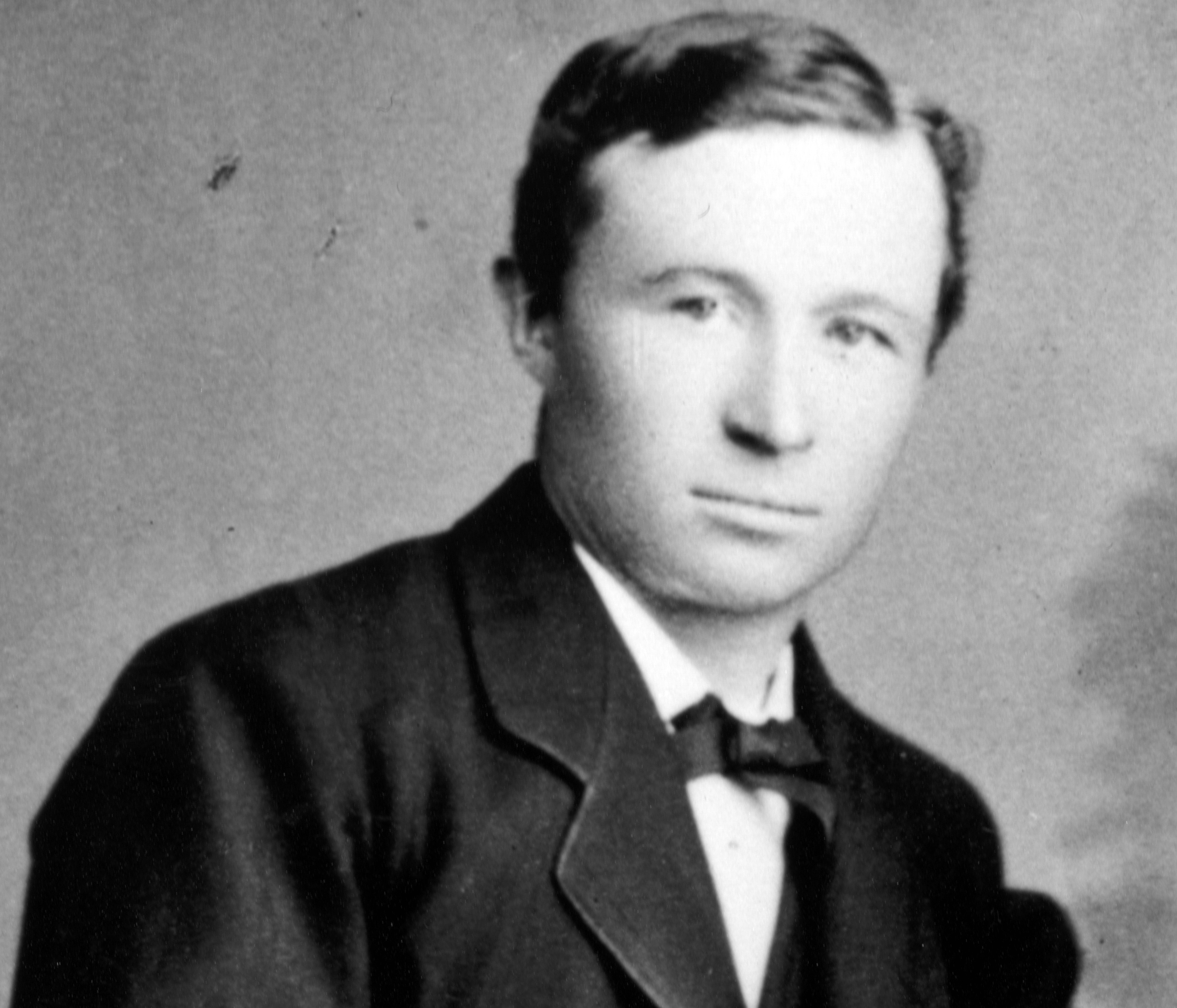
A young Adolph Coors, one of the many German immigrants who arrived here in the late 1800s bringing their beer and beer culture to Colorado.
Of the state’s forty-four pre-Prohibition breweries, only four survived the dry times. And only Coors continued making beer through the rest of the twentieth century. Trinidad’s P.H. Schneider struggled on under several different names and owners until the brewery doors shut for good in 1957. Tivoli in Denver darkened its canning line in 1969, marking the (fortunately temporary) end of the second-oldest continuously operating brewery in the United States. And the beloved-by-many Walter Brewing Company in Pueblo turned off its brew kettles in 1975 (though the brand has since been revived).
As its competitors fell away, Coors continued to thrive. Throughout the late twentieth century, its marketing and the mystique born of its rarity outside the seven states where it was sold made Coors beer practically synonymous with the Rocky Mountain West. By the 2000s, Coors was near the top of its popularity, regularly outselling offerings from bigger volume brewers like Budweiser and Miller. Even with the rise of craft beer, Coors maintained its mystique and enjoyed a massive sales lead over all of the most popular of Colorado’s craft competitors.
Its path to prominence was bumpy. It survived the long dry years of Prohibition, bounced between scandals, and successfully weathered the many controversies stemming from the Coors family’s divisive politics to come out on top. Amid shifting tastes and changing economics that transformed Colorado in the decades after the repeal of Prohibition, Coors remained the Golden brewery with the Midas touch. The story of Colorado’s largest brewery in the twentieth century and the eponymous family that built it offers a window—a golden, effervescent window—onto the forces that shaped modern Colorado. Coors was there for it all, and in many ways, the Coors story is the story of Colorado beer—and of Colorado—for most of the twentieth century.
Taste the High Country
American beer palates shifted lighter after Prohibition. The kaleidoscope of flavorful ales and different styles of lager Coloradans enjoyed in the early 1900s pretty much went extinct by 1933, leaving behind only the most popular pre-Prohibition style beers. That’s why the vast majority of the beers being poured after Prohibition were lighter lagers, which were also by far the most popular in the country before they were outlawed nation-wide in 1920. So by and large, when Americans thought about drinking a nice cold beer as Prohibition drew to a close, they were overwhelmingly thinking about the light effervescent lagers German immigrants like Adolph Coors brought to the US in the latter half of the 1800s.
Always known for its light flavor, Coors Banquet Beer was exactly what many Americans were looking for after Prohibition’s repeal in 1933. Light, drinkable, and not too bitter, it was appealing to a nation of aspiring drinkers who had lost their taste for the more complex brews enjoyed by pre-Prohibition aficionados. Ready on the first day of legal sales, Coors flowed from all the taps the brewery could supply as its midnight convoys fanned out around the state and the Rocky Mountain West. Its ubiquity in Denver and along the Front Range allowed the Banquet Beer to quickly dominate the home market. But unlike the Midwestern brewers that would become its main competitors after World War II, it wasn’t marketing that made Coors a household name in the decades after Repeal. By all indications, its popularity was (at least initially) a genuine reflection of how much people liked the beer.
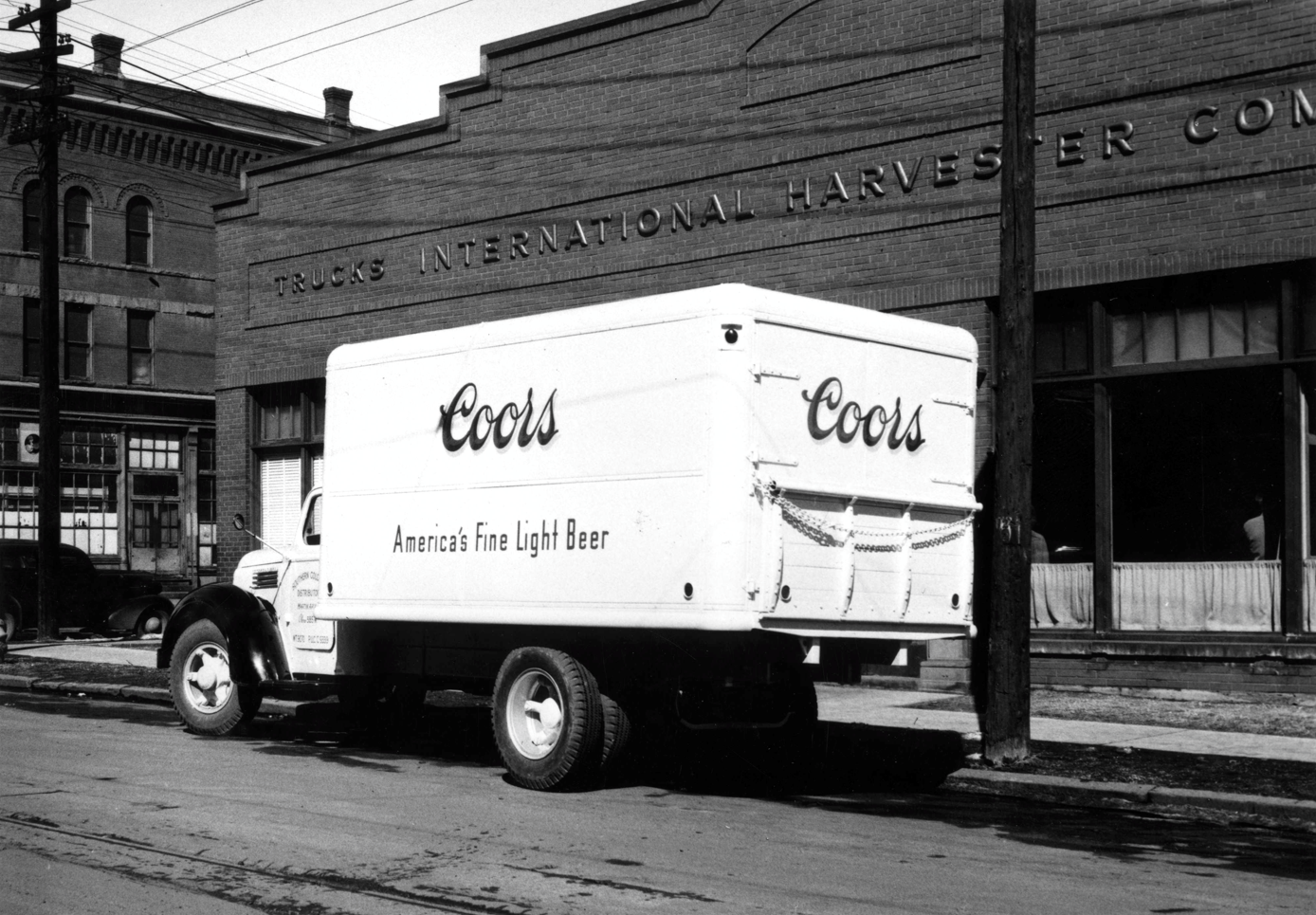
By the 1940s, Coors had invested in a fleet of refrigerated trucks like this one to ensure its unpasteurized beer stayed cold and fresh from brewery to backyard.
The Coors family had never done much advertising for their product before Prohibition, relying mostly on consumer demand and a growing population throughout the West to drive expansion. Whereas the nation’s other industrial brewers devoted up to three dollars of the cost of every barrel they made to marketing, Coors only spent around seventy cents per barrel. Anheuser-Busch, Schlitz, Miller, and Pabst grew their distribution networks to become national brands shipping coast to coast, but Coors focused on selling its beer in only a select number of Western states. While most American brewers were embracing pasteurization to make their beers shelf-stable and chemical agents to age them, Coors relied on old-fashioned methods to ensure the quality remained. As competitors filled the market with a variety of beers designed to satisfy every niche, Coors abandoned styles like light, bock, and amber lagers in order to focus on its flagship original recipe. The company even shelved its new “Coors Light” offering in the early 1940s after only a year of brewing it, keeping the brand locked in the archives until it was reborn as the Silver Bullet in 1978.
In these ways, Coors set itself apart from other large regional breweries and bucked the trends that transformed the brewing landscape all around it. Like Colorado brewers before Prohibition, the family-run brewery in Golden was selling all of the beer it could make, and didn’t bother worrying about things like market share or competition from brewers with larger distribution networks. According to company lore, the quality of their crisp light lager and a robust regional network of distributors kept sales strong, and for more than a century the Coors family found success in doing what they had always done—brewing a “fine light beer.”
By the late 1950s, Coors was the top seller in all eleven states west of the Mississippi in which it was distributed. Brewery chairman Bill Coors—a trained engineer and the third generation of the Coors family to run the company—insisted that the product should speak for itself and reinvested in quality. To ensure it delivered the experience consumers had come to expect, Coors developed a cold-filtering process as an alternative to pasteurization that kept packaged beer cold and sterile, rather than subjecting it to flavor-damaging heat. Cold filtering, the company said, allowed customers to bring home keg-quality beer—something that was impossible with pasteurized beers in cans or bottles. But cold-filtering came at a price. It meant Coors beer needed to be continually refrigerated from brewery to backyard, a fact that layered logistical constraints on the company’s predilection to keep distribution close to home.
Cold filtering and (depending on whom you asked) the taste of the beer itself distinguished Coors from its competition during the 1960s, and enhanced the company’s reputation for putting product quality above expanding sales. Of course, eschewing marketing was itself an especially potent form of marketing in the 1960s and ‘70s as customers turned away from industrialized food and beverage production and toward niche products that came with a regional identity.
By the late-1970s, Coors had taken on a legendary quality among American beer drinkers. The Golden brewery had climbed the industry’s ranks to become the fourth largest brewery in America, even though its beer was still sold (legally) in only thirteen Western states. Luminaries throughout the 1970s (including actor Paul Newman and President Gerald Ford) were known to raise a glass. And the New York Times observed that Coors had “won a reputation as the elixir of beers, the brew of Presidents, a prize to be smuggled into the East.” The author of one popular treatise on beer at the time gushed that “Coors has gone all the way for quality… it must be handled almost like milk.” Time magazine called it the “Chateau Haut-Brion of American Beers,” putting it on a footing with France’s most legendary wines. Even Hollywood offered a cinematic toast to Coors’s mystique with Smokey and the Bandit, a 1977 box office hit that chronicled Burt Reynolds’s highway hijinks as he bootlegged a truckload of Coors from Texas (the farthest east it was legally sold) to Georgia, winning a bet and Sally Field’s heart in the process. Off screen, bootleg cases of Banquet Beer smuggled to the East Coast in the early 1970s fetched many times their retail price, often for beer spoiled by poor climate control.
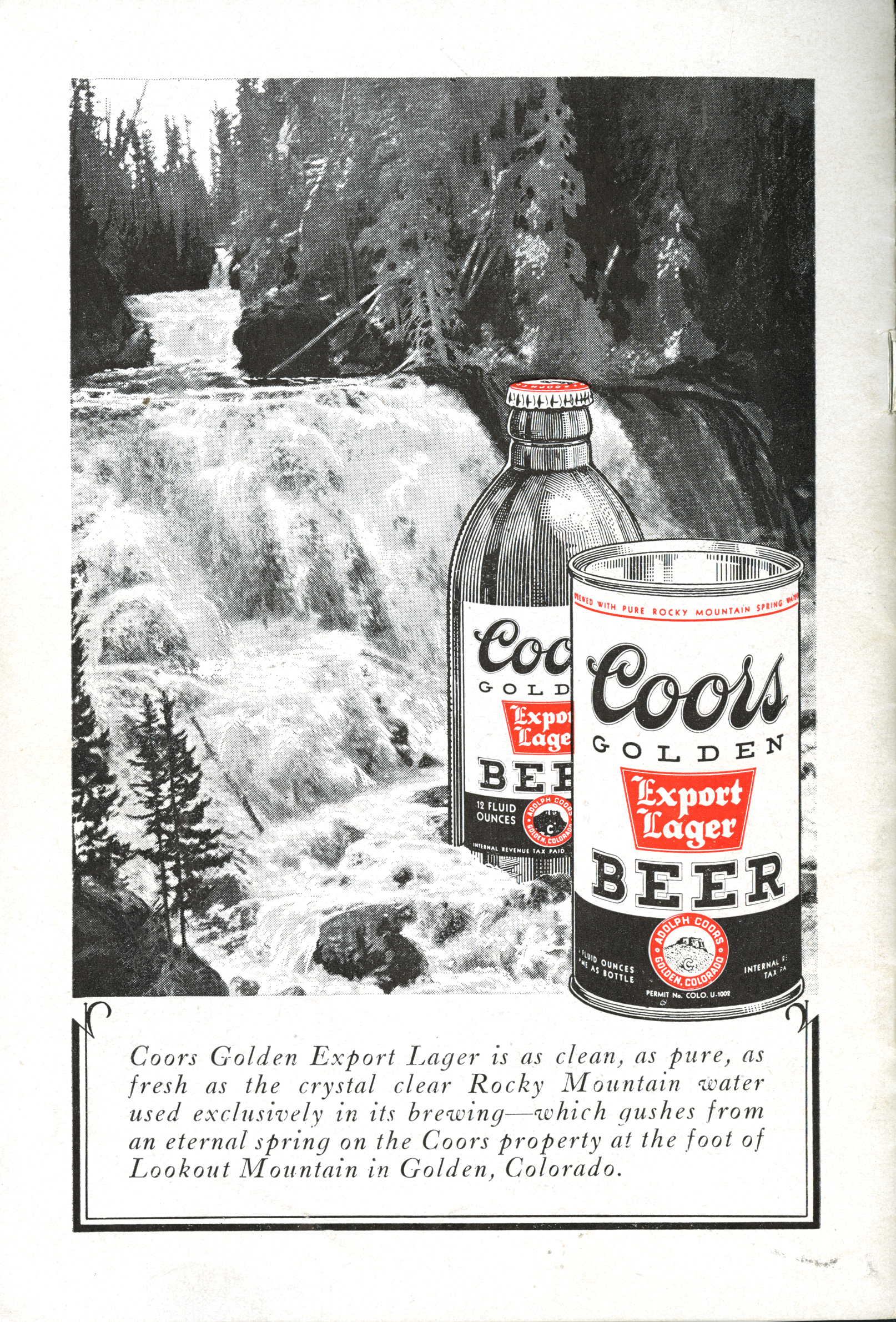
This 1936 ad was part of a long Coors marketing tradition of convincing customers that its beer was special because of the natural splendor of the Colorado high country.
Even in 1978 as Coors began, slowly and sometimes reluctantly, to expand its marketing budget and its distribution outside the West, it held on to its Rocky Mountain mystique. What little marketing the company did usually traded on the mythic purity and beauty of the place where it was brewed. The slogan “brewed with Rocky Mountain spring water” dates to the 1930s, and was featured in the company’s first-ever television spots. Though many brewers touted their water as the special ingredient that set their beer apart from others, Coors advertising leaned heavily on Colorado’s snowy high-country reputation to show (rather than tell) consumers what made its beer different. In one of the company’s early forays into the world of television marketing, an advertisement from the 1950s describes how the purity of snowmelt from Colorado’s granite peaks accumulates in tiny crystal pools, and that the water’s purity is echoed in the “clean, refreshing taste of Coors—a product of the high country.”
Subsequent advertising spanning more than seven decades repeatedly drew a connection between the beauty of the Rocky Mountain scenery and the quality of Coors beer. The messaging stuck, and as Coors expanded its distribution and its marketing budget, the idea that Colorado was a special place with special beer went out across the nation—branding not only the beer, but the Centennial State along with it.
“This is the reason there is only one Coors brewery in the world,” college-football-star-turned-actor Mark Harmon explained to the nation’s television watchers in 1985 as he hiked along a snowy creek near Guanella Pass in the mountains west of Denver. Ducking under a snow-laden branch, Harmon got to the point: “When this snow melts, it’ll flow through miles of porous rock and sand. This natural filtration helps create a clarity, a purity that’s so remarkable, Coors doesn’t have to do a thing to their water. Rocky Mountain spring water. Helps give Coors a difference worth tasting.”
Another 1985 spot had Harmon standing in a field of golden barley, the silhouette of mountains on the horizon behind him, explaining that “most brewers buy their barley, but one’s different. One brewer grows all its own barley, and has for over forty years.” If Rocky Mountain spring water gave Coors its purity, “high country barley” grown with that water in the shadow of mountain peaks gave it its richness.
Advertising that extolled the virtues of Rocky Mountain spring water and high country barley made it clear that the allure of scarcity, the sheen of celebrity endorsements, and the beer’s fine light flavor were not the only things that made Coors popular with its customers. As the company more fully embraced advertising in the late 1970s, it continued relying on this association, linking its beer to Colorado’s extraordinary landscapes and the rugged individualism of the mythic West.
Colorado was a good brand to be associated with during the 1970s and ‘80s. As John Denver’s ode to the “Rocky Mountain High” topped the charts in 1972 and ‘73, the state experienced its largest spike in population growth since the decades of gold and silver rushes a century before. Many of the new residents came for the benefits of living in the Rocky Mountains—the starry skies John Denver sang about on the radio and the snow-clad peaks Mark Harmon extolled on television. By portraying Coors as a uniquely Colorado product, memorable advertisements added to the mystique by reinforcing the notion that the beer was special because of its place of origin. And it didn’t hurt that commercials featuring Harmon hiking in the snow or pulling a Coors out of a crystal-clear mountain lake also encouraged beer drinkers to bring a cold can of Coors along when they headed outside to enjoy the West’s natural beauty, encouraging the easy-to-embrace habit of Coloradans bringing a cold can of beer into the backcountry with each outdoor activity.
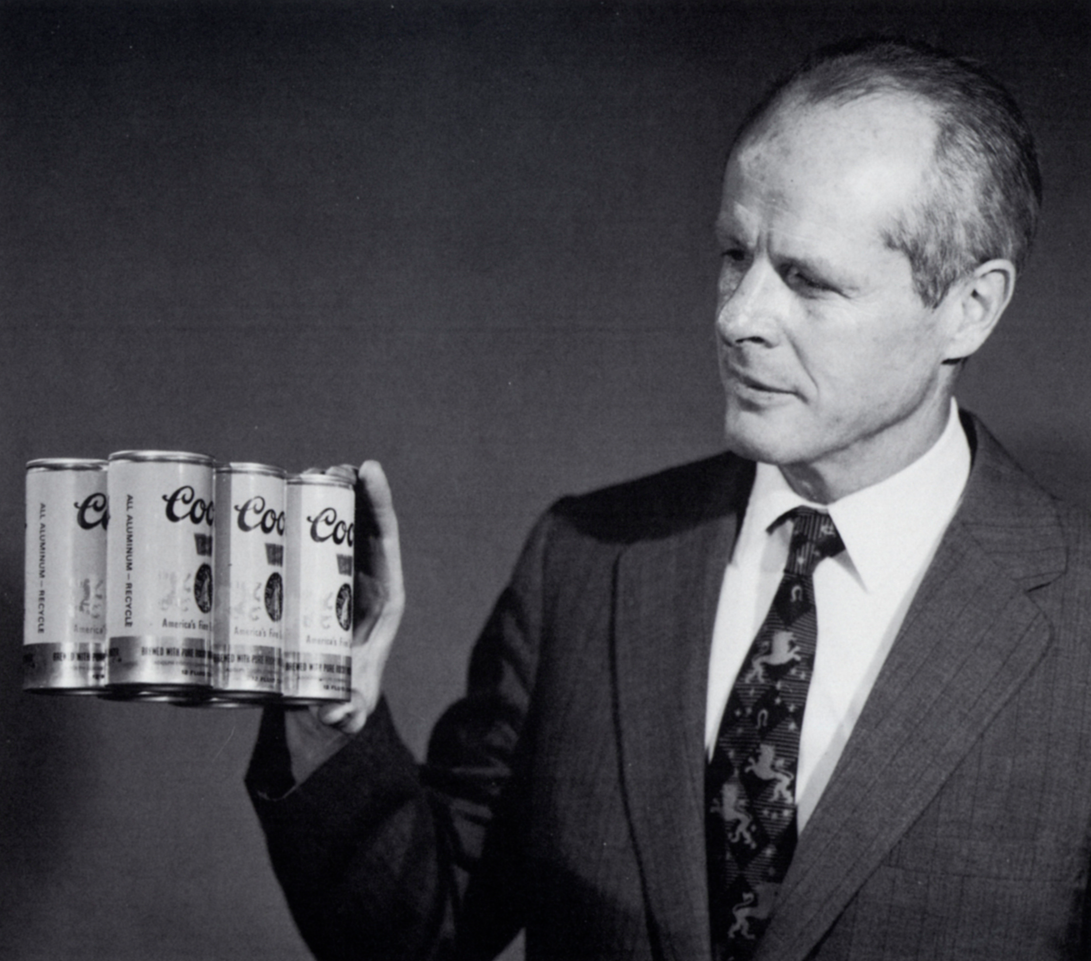
Brewery Chairman Bill Coors, with the seven-ounce aluminum beer cans he helped pioneer in 1959. It was the nation's first large-scale aluminum beer canning operation.
Cash for Cans
More than simply cheering outdoor recreation, Coors also heralded the era’s growing environmental ethos by developing the beverage industry’s first aluminum cans. Searching for an alternative to steel cans, which were expensive and liable to leak and to produce off-flavors in beer, Coors debuted the nation’s first mass-produced two-piece aluminum beer cans in 1959. The new two-piece aluminum cans sealed better than the three-piece steel cans brewers used throughout the early twentieth century, so the new cans better protected the beer’s flavor. As a bonus, aluminum’s infinite recyclability meant that if the brewery collected enough used cans, it could stop purchasing aluminum slugs and begin manufacturing its own from recycled materials. Recycling would cut costs and allow the company to simultaneously boost its image as stewards of Colorado’s spectacular environment (especially that Rocky Mountain spring water) by instituting a can buy-back program—a public relations perk touted as a design element that the Denver Post later called a “salvage feature aimed at cutting down litter.”
Cutting down litter was important, as empty beer cans had become such a common sight littering the nation’s highways and scenic places that they were often invoked as a symbol of America’s wasteful consumer culture. In Colorado, caretakers at mountain parks along the Front Range complained of the piles of empties left behind by outdoor partygoers, residents of mountain towns worried that beer cans and other trash along the road would hurt tourism, and the state’s chief highway engineer lamented how much time maintenance crews wasted repairing flat tires popped by shrapnel when their mowers ran over another beer can.
Beer cans were such a symbol of the litter problem that a popular 1961 book about the issue was titled The Beer Can by the Highway: Essays on What’s American About America. The author, Barnard College Professor John A. Kouwenhoven, drew national attention to the litter problem, and particularly to the beer can’s contribution to mounting garbage, arguing that discarded beer cans were emblematic of a society with so much material wealth that consumers did not give a second thought to the problem of waste. The book tapped into a growing number of Americans’ fears about pollution, concerns that were propelling the American environmental movement toward political prominence.
Bill Coors acknowledged the bad optics of so many beer cans—often emblazoned with his family name—littering otherwise-pristine-looking western places he enjoyed visiting himself: “Beer cans along the highways, in the parks and at picnic grounds have become a major public relations problem for the brewing industry,” he explained to Denver’s Rocky Mountain News in 1955. “We think the answer may lie in returnable aluminum cans,” he continued, outlining the company’s efforts to develop a better beer can.
When the company introduced the aluminum beer can a few years later in 1959, news reports relayed the company’s hope that the can’s recyclability—and the incentive of a penny per can to those returning them—“will help reduce litter on highways and picnic grounds.”
His hope was quickly realized, and by 1965, Coors was boasting that it had brought home sixty million empties after consumers had enjoyed their contents. In Colorado and Wyoming, the heart of Coors Country, more than eighty-five percent of the company’s cans were being returned. “For our part we regard it as an investment in preserving the native beauty of our country,” a company spokesperson told the Rocky Mountain News. “We’re proud you seldom find a Coors aluminum can along the roadside or marring the approaches to a trout stream.”
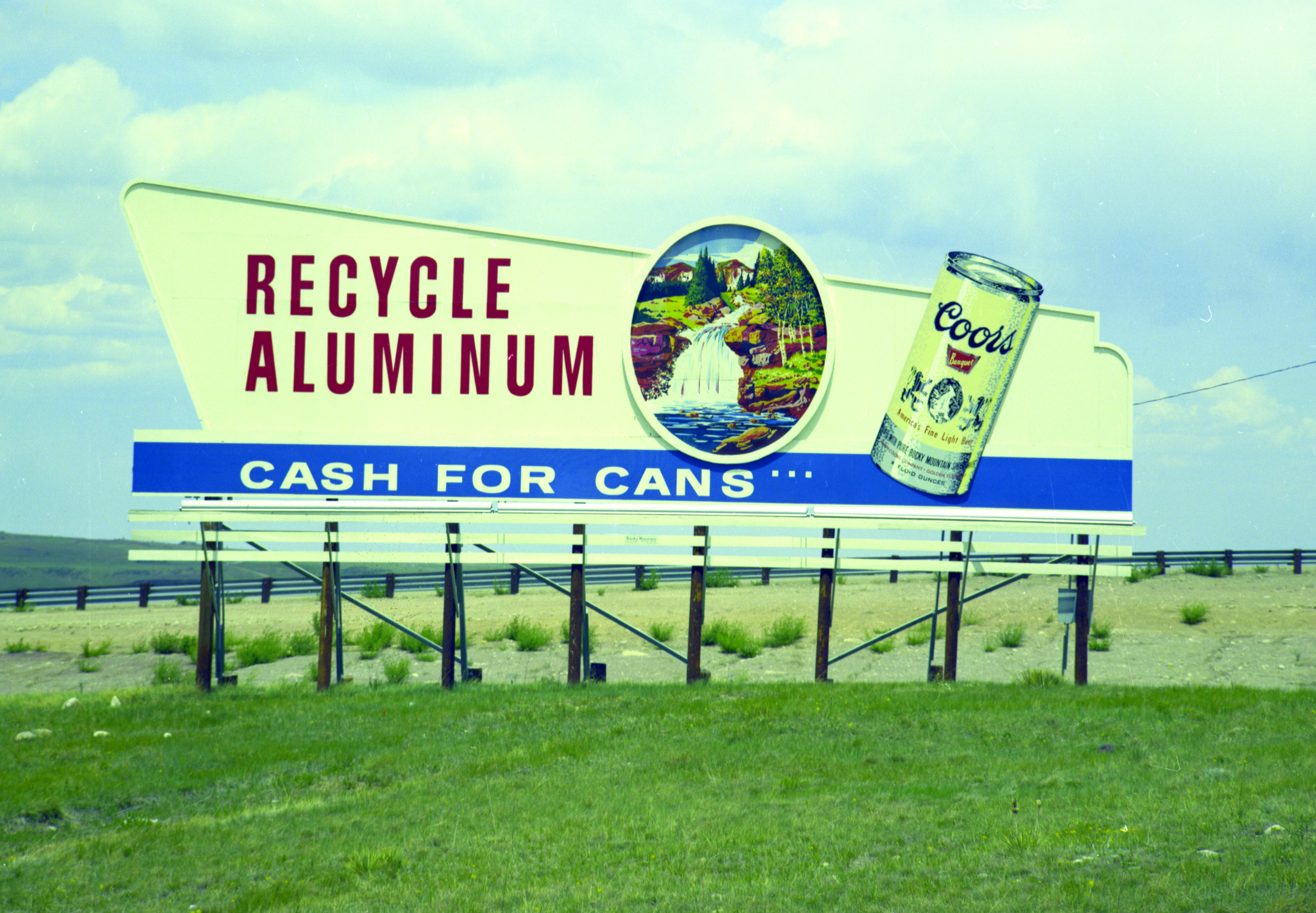
Coors launched a buyback program for its cans in 1959. Later it would build its own can manufacturing plant that used recycled aluminum from the cans it collected. That canning business would later become part of the Ball corporation, today one of the nation’s largest aluminum can manufacturers.
In 1970, as more and more brewers and other beverage makers adopted Coors’s aluminum can design, the company expanded its recycling efforts. Coors launched a “Cash for Cans” program that paid consumers to return their used aluminum cans regardless of who had made them, giving all consumers an incentive beyond environmentalism to stop tossing empties to the side of the road. Speaking to the Rocky Mountain News in January 1970, Bill Coors explained that “aluminum is the best possible answer to litter because it is salvageable.”
Not only that: By recycling aluminum rather than buying new supplies, the company could save on the cost of raw materials. Thanks in large part to Coors’s efforts, by 1985 Colorado led the nation in aluminum can recycling. Touting the company’s leadership in the “full-scale effort to keep America clean and inviting,” Coors bolstered its bottom line and its brand at the same time, ensuring its appeal to a growing segment of the middle class falling in love with the outdoors and justifiably concerned about ecological legacies. Coors’ strong identity as a uniquely Colorado company fit well with this environmental ethos. By the same token, Coors advertising showcased an appealing version of the Rocky Mountain lifestyle and cultivated a Western cachet that helped establish Colorado’s brand in the minds of Americans throughout the country during the second half of the twentieth century.
The contours of the state we know today echo the Colorado that appeared on television and the radio thanks to Coors (and John Denver). With state and federal investment in highways providing unprecedented access to alpine amenities, it was easier than ever for tourists and homeseekers alike to enjoy a taste of the Rockies. Half a million people liked Colorado so much that they decided to move here in the 1960s and ‘70s, increasing the state’s population by twenty-five percent in just ten years. By the 1980s, the word was out: Colorado was a great place to live, and to drink beer. And Americans flocked to Coors Country en masse.
Beer in the ‘Burbs
As Americans entered the decades of optimism and prosperity that followed years of economic depression and World War II, pent-up demand for new housing and cars fueled suburban construction booms across the country. For millions of Americans, (particularly white military veterans supported by the GI Bill, government mortgage programs, and other financial benefits not extended to Black soldiers), the American dream of homeownership was suddenly within reach. But whereas railroad and streetcar lines had shaped growing cities during earlier generations, highways drove post-war growth—literally. The individualized mobility long-range automobiles afforded some families allowed them to purchase homes far from the city center, fueling demand for single-family dwellings, but also fueling white flight and disinvestment in communities of color that were left behind.
In Colorado, a significant portion of the economic growth underpinning suburban expansion was fueled by federal government spending related to countering the perceived threat of Communism during the Cold War. Particularly along the Front Range, the US government expanded military installations like the Ft. Carson Army Base in Colorado Springs, the Pueblo Ordnance Depot, and the Rocky Mountain Arsenal near Denver. The feds also built new facilities such as the Air Force Academy and the Air Defense Command in Colorado Springs, the Rocky Flats nuclear plant between Golden and Boulder, and the Federal Center in Lakewood (on the site of the old Denver Ordnance Plant). Scientific labs were established near Boulder, including the National Center for Atmospheric Research and a branch of the National Bureau of Standards. These agencies took advantage of the brainpower concentrated at the nearby University of Colorado, which also flourished with each new grant. In all, federal defense and research spending accounted for more than twenty percent of Colorado’s revenue between 1952 and 1962. That figure was amplified by the arrival of defense and technology companies, and by federally funded projects like the construction of interstate highways.
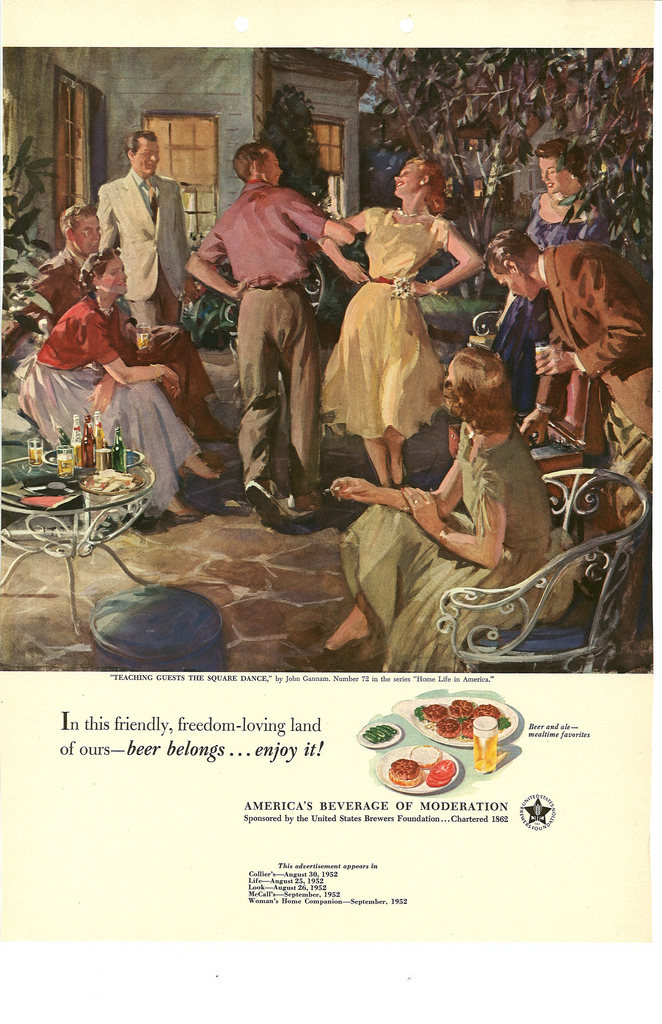
Between 1945 and 1956, the “Beer Belongs” series (also known as “Home Life in America”) created over 100 advertisements featuring Americans enjoying beer in a variety of familiar settings.
Colorado’s population surged alongside all of this investment, and good-paying jobs weren’t the only thing bringing people here. A growing appreciation for the state’s natural amenities helped attract a rush of new residents during the Cold War decades. In the twenty years between 1950 and 1970, the number of Coloradans grew from 1.3 million to 2.2 million. Most of the new residents settled near Denver. Suburban communities expanded from what had been small farming or mining settlements, or simply emerged as new intentionally planned towns, as folks found their own slice of the American dream in the vast tracts of single-family homes built in places with names like Thornton, Aurora, Lakewood, Westminster, and Littleton. These suburbs added nearly 560,000 new residents during that period, while the population of Denver proper increased by fewer than 100,000— a demographic shift that fundamentally re-shaped the character of Colorado’s Front Range and revealed the racial boundaries these new suburbs intentionally drew around their communities.
White communities on every side of Denver, which the real estate industry’s redlining practices ensured were out of reach to most people of color, expanded dramatically outward while a growing network of highways linked them into an interconnected metropolitan area. When the Denver-Boulder Turnpike opened in 1952, Boulder was a sleepy university town of just over 20,000 residents, including University of Colorado students. By 1970, however, the highway had linked it conveniently with the burgeoning metropolitan area, and Boulder’s population more than tripled to 66,870. Nearly fourteen thousand travelers each day were paying the twenty-five-cent toll to go back and forth on the turnpike between Denver and Boulder. All across the new metropolitan area, suburbs appeared offering three-and four-bedroom homes with around one thousand square feet for about thirteen thousand dollars. But the combination of high prices (for that time) and racist real estate practices discouraged (and sometimes actively prevented) non-white people from moving there.
As people in Colorado and throughout the country headed out to the suburbs, beer followed them home. In 1945, a trade group of brewers calling themselves the United States Brewers Foundation launched an advertising campaign aimed at depicting the ways in which “Beer Belongs” at home. Between 1945 and 1956, the “Beer Belongs” series (also known as “Home Life in America”) created over 100 advertisements featuring Americans enjoying beer in a variety of familiar settings like backyard barbecues, family gatherings, gameday parties, and vacation spots.
Created by some of the best commercial artists and illustrators of the day, the ads ran in popular magazines such as Time, The Saturday Evening Post, Collier’s, U.S. News, and more. Each idyllic vignette featured white middle-class men and women enjoying leisure time and beers together, and most featured larger groups of smiling friends and family with even numbers of men and women. Prohibition had only been over for a little more than two decades, and every ad insisted that “Beer Belongs,” often appealing to patriotism and the hunky-dory post-war optimism flooding the country: “In this friendly, freedom-loving land of ours—beer belongs. . . enjoy it!” Many also reminded viewers, emphatically, that beer is “America’s Beverage of Moderation.”
Advertisements with longer copy extolled beer’s role in the good life at home in America:
“In this home-loving land of ours. . . in this America of kindliness, of friendship, of good-humored tolerance. . . perhaps no beverages are more ‘at home’ on more occasions than good American beer and ale. For beer and ale are the kind of beverages Americans like. They belong—to pleasant living, to good fellowship, to sensible moderation. And our right to enjoy it, this too belongs—to our own American heritage of personal freedom.”
Themes of domesticity, freedom, and patriotism were especially resonant during the Cold War years, and the strategy worked spectacularly well. In 1940, fewer than half of American families had been in the habit of bringing beer home to drink. But by 1950—five years into the “Beer Belongs” campaign—that the share had risen to two-thirds of the nation’s households. And in beer’s new domestic setting, women were enjoying it along with men. By 1954, the Brewers Foundation was reporting that four in ten women nationwide drank beer, accounting for twenty-two percent of all beer consumers.
The basic strategies and trends established after Repeal were carried forward and amplified through the 1950s, ‘60s, and ‘70s, as sales of bottles and cans climbed to eighty percent of all beer. But people of color were notably absent from the “Beer Belongs” ads. Out of more than 100 unique advertisements, not one features a person of color. The implicit message from the brewing industry was that, even though non-white people may have been able to buy beer, the ability to drink it in the backyard of their own homes was going to continue to be out of reach for many. Coors was not part of the “Beer Belongs” campaign, but the decision other brewers made to market to an audience of white Americans who were abandoning city centers for highway-connected suburbs reflected very real racial tensions that would come to a head in Colorado during the 1960s and ‘70s, and in many ways persist to this very day.
As Colorado entered the latter half of the twentieth century, many of its residents were riding high on what seemed to be an unprecedented wave of optimism and prosperity in comfortable suburban homes. People of color may not have been so lucky—for many in Colorado’s non-white communities, beer advertisements were yet another reminder of the discrimination they faced in choosing where to live and work. So even while beer was held up as a great way to celebrate the good life, it had also become a symbol of the ways the American Dream wasn’t available to all.
“Chicanos Stop Buying Coors!”
Coors may have been a darling of the beer world during the 1960s and ‘70s, but not everyone was in love. In the late 1960s, activists in Colorado’s Chicano Civil Rights Movement, known as El Movimiento, were calling for a boycott of Coors to protest unfair hiring and promotion practices at the brewery. Labor unions, gay and lesbian groups, the NAACP, and other civil rights organizations in Colorado and around the nation joined the boycott, all citing unfair or discriminatory treatment. By the 1990s, running skirmishes with unions and a change in the brewery’s leadership brought about a major shift in company policies that reflected a reorientation of the relationship between consumers and companies. With social consciousness on the rise and in vogue during the era’s push to expand civil rights to all Americans, consumers took to voting with their wallets, making clear their expectations that companies commit to supporting racial equity. Corporations large and small across the country found themselves subjected to boycotts because of discriminatory labor policies, and some of these boycotts—like the one targeting Coors—would live on for decades.
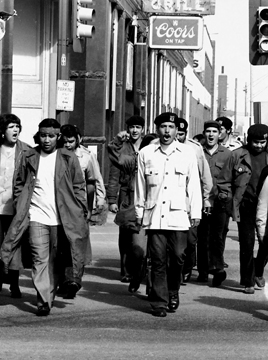
The Brown Berets marching in Denver during the boycott against Coors in 1973. They were protesting racially-biased hiring and promotion practices at the Golden brewery.
The protests of the 1960s and ‘70s were by no means the first time Coors found itself at the center of controversy. Notoriously unfriendly to the cause of organized labor, the Coors Brewing Company had long tangled with strikers: What was an initially irksome labor dispute over worker pay grew into a full-blown strike in 1890 when the company initially refused to meet its workers’ demands. Crisis was averted and workers were back on the production line the next day after the company grudgingly agreed to a thirty-cent raise and a guaranteed ten-hour workday. But the specter of labor unrest had risen, and would continue looming over the Golden brewery for the next half-century. Negotiations with workers devolved into strikes with some regularity over the years, and the brewery’s management grew increasingly impatient with each disruption. “For years we have been harassed by the union,” remarked Grover C. Coors in a 1916 quote to the Colorado Transcript summarizing his family’s continuing frustrations with organized labor.
Historians of the company regard the dry years as a watershed moment for the Coors family in that it crystallized the dangers of government regulation and organized labor to their company’s survival. Some form of labor organization was almost certainly present in the brewery early on, and may have been imported from brewers guilds in Europe. But either way, recurring strikes indicate that Coors resisted labor demands from the very beginning. Following Prohibition’s repeal and the return to beer sales, the Coors family, and Joe Coors in particular, took on a personal role in ensuring that the government would be restrained in its power to take away the family’s livelihood and that unions would never again threaten the brewery’s bottom line.
After a botched kidnapping took the life of Adolph Coors III in 1960, his brother Bill Coors took over day-to-day management at the brewery. With Bill focused on maintaining quality and rolling out his new aluminum cans, the third brother, Joe Coors, waded into the nation’s increasingly fractious politics just as the civil rights movement of the 1960s was reorienting American politics.
Racial divides—for so long the central question at the heart of American politics—were reset with the Civil Rights Act’s passage in 1964. Suddenly, reliably Democratic blue states turned Republican red as the GOP became a haven for those who saw the Civil Rights Act turning the country in an uncomfortable direction and anti-war protestors as Communist sympathizers.
This political reorientation unfolded rapidly from the ground up as a grassroots movement, but business leaders who argued that governments at all levels had amassed too much power gave it further momentum. By the 1970s, America’s political system had almost completely turned on its head. The Republican party shied away from promoting progressive values, while Democratic politicians—historically conservative and supportive of racist policies like the Jim Crow laws throughout the South—embraced racial equality and liberal fiscal policies. Contemporaries and historians dubbed these parties “The New Right” and “The New Left.”
For Joe Coors, a believer in the values expressed by the New Right, the threat of Communism and a sense that government regulations were strangling American entrepreneurs set him in motion. When a seat on the University of Colorado’s Board of Regents opened up in 1966, Joe threw his hat in the ring. His campaign focused on combating Communism (which he argued was on the rise within the University’s left-leaning academic community) and on ensuring that conservative voices were not being sidelined at CU. Joe won the seat in 1967 and quickly moved to enact anti-Communist policies. Joe pushed the university to start mandating faculty loyalty oaths, but his fellow Regents and some faculty members weren’t so eager to take such a strong stand. Some complained to the press that he was using his position to “propagandize right-wing extremism” when he distributed anti-United Nations materials from the John Birch Society, a conservative organization that advocated strict limits on government interference with private enterprise.
The following year, Joe played a leading role in banning the influential Students for a Democratic Society (SDS) organizing group from campus, and brought a rising conservative luminary, California’s Governor Ronald Reagan, to speak in Boulder. Taking on an ever-more-prominent role in the conservative movement, both in Colorado and on the national stage, Joe became somewhat of a figurehead for the social flashpoints of his home state after a fiery commencement address given to graduates of the Colorado School of Mines in 1969. To a surprised audience, Joe railed against welfare recipients, hippies, and “pleasure-loving parasites” who are “satisfied to live off the state dole and handouts in a carefree existence.”
Joe’s tenure as Regent lasted six years, and proved an important springboard for his growing political activism. The contacts he established as Regent—most notably a personal and financial relationship with soon-to-be President Reagan—lent him a megaphone through which he would advance his political philosophy within state politics. And Joe certainly found receptive audiences for his messaging in Colorado, a state where, at the time, the majority of voters were dependably conservative. But his last name was Coors, and with the brewery’s rising prominence in the beer industry, it was clear that the Coors family and its brewing company were being dragged together into a fight over the state’s political future.
Among those gearing up to offer a competing political and social vision were brewery workers from the Latino community who confronted discriminatory hiring and promotion practices long in place at Coors. Around the same time that Joe Coors was standing up for the conservative social values he felt were under threat at CU, a new civil rights movement was gaining ground in Colorado. El Movimiento grew out of rising cultural pride in Chicano identity in the 1960s and ‘70s, and directly tackled entrenched racial discrimination against people of Latino descent across the state. In Denver, local boxing legend and poet Rodolfo “Corky” Gonzales became an outspoken leader who helped catalyze widespread protests. In 1967, Gonzales and others helped found The Crusade for Justice—an organization that joined the fight against discriminatory employment policies among other injustices by taking aim squarely at the Coors Brewing Company.
The complaint against Coors alleged that, like many other large companies in the state, the brewery discriminated against Latino workers by hiring them primarily for unskilled or low-paying positions. The company’s workforce was overwhelmingly white and male well into the 1970s (it had hired its first African American employee only in 1962), and despite Latino workers making up about thirteen percent of the local labor pool, only two percent of Coors’s workforce came from Latino families. Many Colorado companies, then and now, have struggled to address their discriminatory hiring and promotion practices, but unlike less-iconic Colorado companies, Coors made a popular and easily-recognizable product with an outspoken leader representing the forces that many believed maintained the discriminatory status quo. Joining with a coalition of allies including local unions, the Crusade for Justice allied with groups like the GI Forum to kick off a boycott of Coors beer calling for equitable employment practices and more opportunity for Latino workers at the Golden brewery.
Protests spread out from Denver and Golden in the late 1960s until the choice of beer became a signal for a person’s political leanings throughout the state. Public protests weren’t limited to the Golden brewery: Forty-three students at Southern Colorado State College (now Colorado State University Pueblo) joined hands around the campus pub to protest the sale of Coors in 1967, adding their voices to a rising chorus of anti-Coors sentiment. Taking place against the backdrop of Cesar Chavez’s California’s lettuce and grape boycotts, the Coors protests shone a national spotlight on discrimination in Colorado’s businesses and on the Coors family itself. That spotlight was intensified in 1977 when the American Federation of Labor and Congress of Industrial Organizations (AFL–CIO) called for its member unions to join the boycott in support of yet another labor strike at the brewery.
The Coors Brewery’s influence over its unions grew through the early part of the century, and the company used a combination of generous perks and active dissuasion to erode labor organizing in the brewery. Labor action was seldom successful, and more often than achieving concessions, strikes resulted in dissolution. In spite of all of the pressures on the company, the 1977 strike ended in a spectacular victory for Coors. The family deftly played its cards, going on a charm offensive with a spot on the TV news program 60 Minutes while hiring strikebreakers who forced its union to vote for decertification. The upshot was that, while the boycott was still in effect, the Coors Brewing Company achieved a century-spanning dream—it was finally free from the ever-present irritation of organized labor.
Though the original movement to boycott Coors officially ended in 1987 when the AFL-CIO came to an agreement with Joe’s son and newly-minted company chairman Peter Coors, it lives on in the hearts of many who cannot forgive the company for its initial refusal to address racially discriminatory practices. For others who still refuse to drink Coors beer, it’s impossible to ignore the family’s role in the rise of the New Right and in advancing a political philosophy at odds with their own. Ultimately, the long-running boycott did not produce any clear-cut victories for the activists, but it did tarnish the company’s mystique. By the late 1980s, a new generation of leadership embodied by Peter Coors (and eventually mergers with international beer brands Molson and Miller) made amends with some of the communities the company had offended. More recently, the company has been noted for its corporate citizenship, particularly in its support of gay and lesbian consumers and employees: in the early 1990s, it was among the first large American corporations to extend spousal benefits to same-sex couples.
The boycotts and labor problems at Coors represent a fundamental shift in the relationship between consumers and corporations in America, and through the social turmoil of the 1960s and ‘70s, Colorado was playing an ever-growing role in national political conversations. During these decades the Centennial State, long known for the natural resources its mountains, mesas, and plains supplied to manufacturers throughout the country, became more fully knitted into the social and economic fabric of the nation, as the state’s explosive population growth and quality of life put Denver on the map as one of the best places in the country to live, work, and drink beer.
Homegrown
Even though sales at the brewery slowed somewhat as a result of the boycott and strikes, the 1960s and ‘70s represented Coors Brewing Company’s most significant period of growth. Brewing enough Coors beer at the Golden brewery to satisfy its clamoring devotees required a large and ever-increasing amount of barley and hops, and like Colorado brewers of the past, Coors was faced with challenges in securing adequate and reliable supplies of its key ingredients. In response, the company sought to ensure quality and control cost by bringing as many aspects of the brewing process as possible in house. As Coors expanded, quality and price control through vertical integration of the various aspects of the brewing business would become one of the company’s hallmarks.
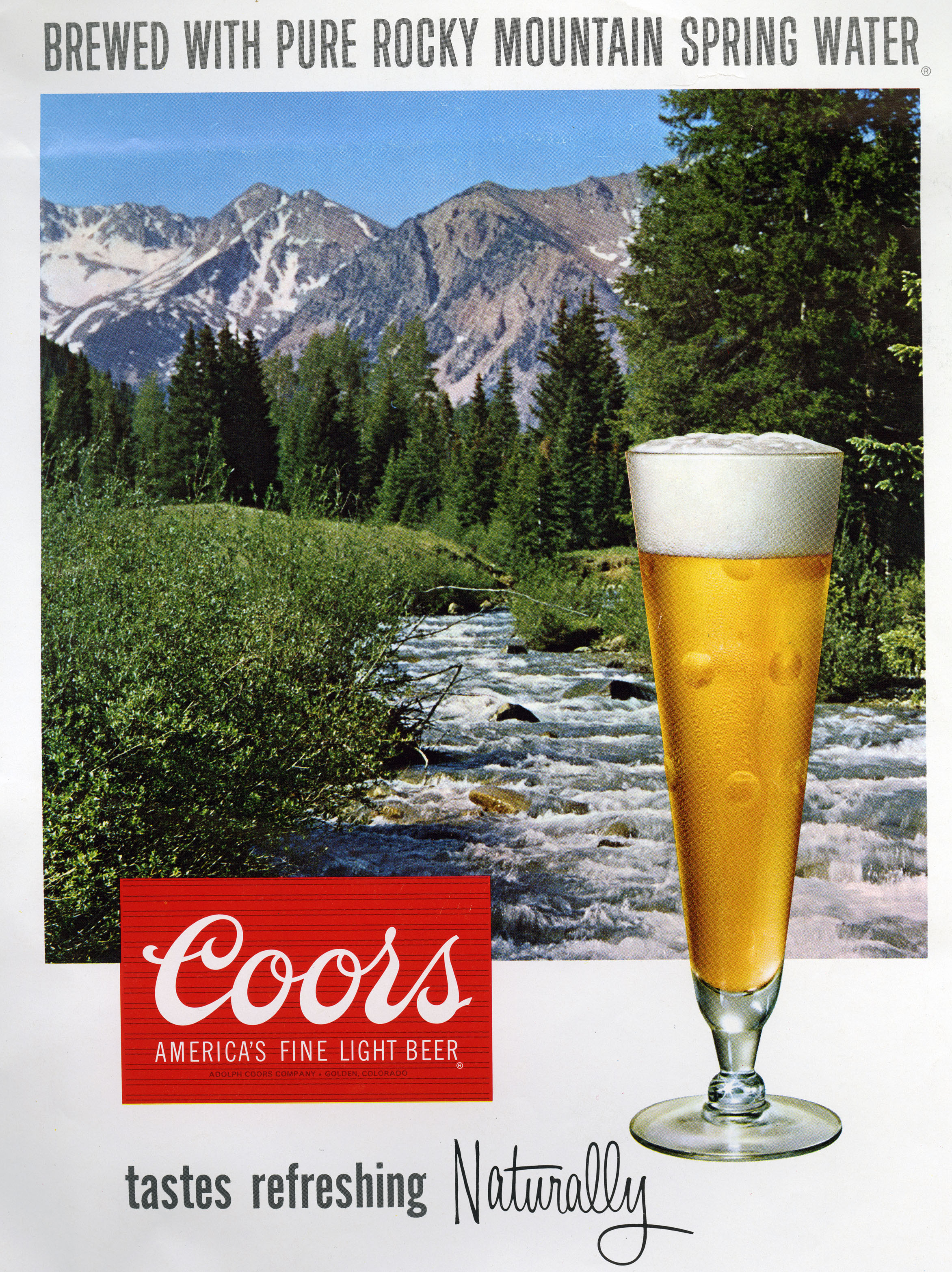
Colorado’s brand was on the rise in the 1970s, and nobody did more to spread the Rocky Mountain mystique than Coors (and maybe John Denver). Advertisements like this one traded on the beauty of the place where it was brewed to mark Coors beer as unique.
This was particularly true of barley. Company President Bill Coors often summed up the brewery’s appreciation for barley by saying that “barley is to beer as grapes are to wine. You cannot make a good wine out of bad grapes and you can’t make a good beer out of bad barley. You can make a terrible beer out of good barley. That’s easy to do. But at least start right.” For the Coors family, barley was second in importance only to the pure Rocky Mountain spring water the company had touted in its advertisements since 1937.
Like other brewers before Prohibition, Aldoph Sr. offered seed and incentives to Colorado growers in order to ensure a supply of quality barley for his operation. During the 1898 planting season, he ran advertisements proclaiming that “I would like to see more barley raised in our country and offer nice, clean, four rowed Scotch seed barley at $1.00 per 100 lbs. I am willing to contract for No. 1, clean barley raised from this seed at $1.00 per 100 lbs. delivered at brewery. Screenings returned. A. COORS.” In a fashion characteristic of Adolph’s conviction that others couldn’t attend to the beer’s quality in the same way he would, the barley was malted at the brewery, avoiding out-of-state distributors and the potential for any unscrupulous character to mess up the product.
After Repeal, when large breweries increasingly outsourced their supply chains to expand capacity and cut costs, Coors doubled down on its in-house barley program. The initiative began in 1937 when Coors received a small packet of extra seeds in that year’s two-row Moravian barley crop. The packet was included with an order of malt from R. Karsten Ltd in Prague. Coors gave the seeds to a gardener in Golden to test their suitability to Colorado’s climate, and when the barley grew well, the company began working with more growers to scale up over the next few years until it was ready to be malted and tested in the beer. The result was good, and 1945 consumers were able to enjoy the first Coors lager made with locally-grown barley for the first time.
Coors scaled up the barley program quickly, enhancing the vertical integration of its operations and further tightening its control over the entire supply chain. A breeding program at the experimental farm the company created in 1949 in the San Luis Valley developed improved high-altitude varieties from the original seed stock (using Mendelian methods—Coors says that it does not genetically engineer its barley). Grain storage facilities were built beginning in the 1950s near Loveland, and in Monte Vista in the San Luis Valley, collecting barley directly from the farmers and storing it until it was needed at the brewery in Golden, where a large new custom-designed malthouse was completed in 1957.
By the mid-1950s, the locally grown high country barley had joined the famous Rocky Mountain spring water as another uniquely regional asset to the brand. A pamphlet prepared for barley growers touted “this climate and our certified seed strain” as the reasons for its “superior malting barley.” The company billed itself as “Makers of Coors, America’s Fine Light Beer. . . Produced from Moravian Malting Barley Grown by Colorado Farmers.”
The first Colorado farmers to grow Coors barley were concentrated in the San Luis Valley and in northwest Colorado, but as demand for Coors continued to grow, and particularly as the company began expanding its distribution area in the 1970s, the need for barley grew in concert. Coors began working with farmers outside of Colorado, expanding into the Northern Rockies to develop growing areas in Wyoming, Idaho, and Montana. By 1971, the company had contracts with more than 500 farmers in several Rocky Mountain states for six million bushels of barley, for which Coors paid $2.01 per bushel at the elevator. The company’s expansion plans called for more than doubling the harvest to 12.5 million bushels by the end of the decade.
Since the days when Adolph Coors Sr. offered to return “screenings”, which was maltster language for barley kernels that were not up to his standards, the brewery had always imposed strict quality requirements on its barley growers. As the barley growing program expanded during the latter half of the twentieth century, Coors dictated increasingly rigorous specifications in its contracts for the barley it would accept. Dealing in ever-larger scales of production amplified the need for such rigorous quality standards. A slight increase in the protein level of barley can reduce the final volume of beer it produces, and even small percentage reductions mean significant shortfalls when amplified across tens of millions of barrels of production annually.
In the pursuit of higher quality and more reliable supply, the company even tried to impose stricter specs on nature in order to insulate its supply chain against crop shortfalls and price shocks. Ever the engineer, in 1972 Bill Coors launched a cloud seeding program in the San Luis Valley in an attempt to suppress hail and optimize the weather for barley growing, thus enhancing the reliability of the barley supply. When ranchers and other growers in the valley balked at the idea of manipulating the climate just to make more beer, the company threatened to terminate contracts with twenty percent of its growers each year until they valley was supplying only ten percent rather than sixty percent of Coors’ barley needs or the growers brought their fellow citizens around to a weather management program. Noting that the company had developed other options, Bill Coors explained that “ten per cent is the maximum amount we are prepared to place at the mercy of the natural elements which in our experience will give us a good quality crop once in twenty years.”
Valley residents never agreed to the weather modification program, but at least the company did not fully follow through on Bill Coors’ threat to marginalize the region. A preference to contract with irrigated operations has mitigated some of the vagaries of the weather and expansion in other areas has reduced the company’s reliance on the San Luis Valley, but farmers there still grow a significant portion of Coors’s unique strain of Moravian two-row barley.
The company’s insistence on only buying the highest-quality barley from local growers established an early and strong market for the brewer’s grain in Colorado. Modern malt houses flourishing around the region supplying the barley that fermented the craft beer boom owe much of that success to the Coors barley program. Since the end of World War II, Coors has been brewing massive volumes of beer, and the barley needed to meet the brewery’s demand has been one of the biggest markets for brewing barley in the West, and many of Colorado’s craft breweries found a ready-supply of brewing ingredients homegrown in the Centennial State thanks to Coors and its barley program.
Colorado probably would have become a great place to drink beer and enjoy the great outdoors with or without Coors. But the company was willing to share both its expertise and ingredients with Colorado’s craft brewing pioneers, insulating the risky early startups of the craft brewing world from some of the problems that starting a new industry completely from scratch would have imposed.
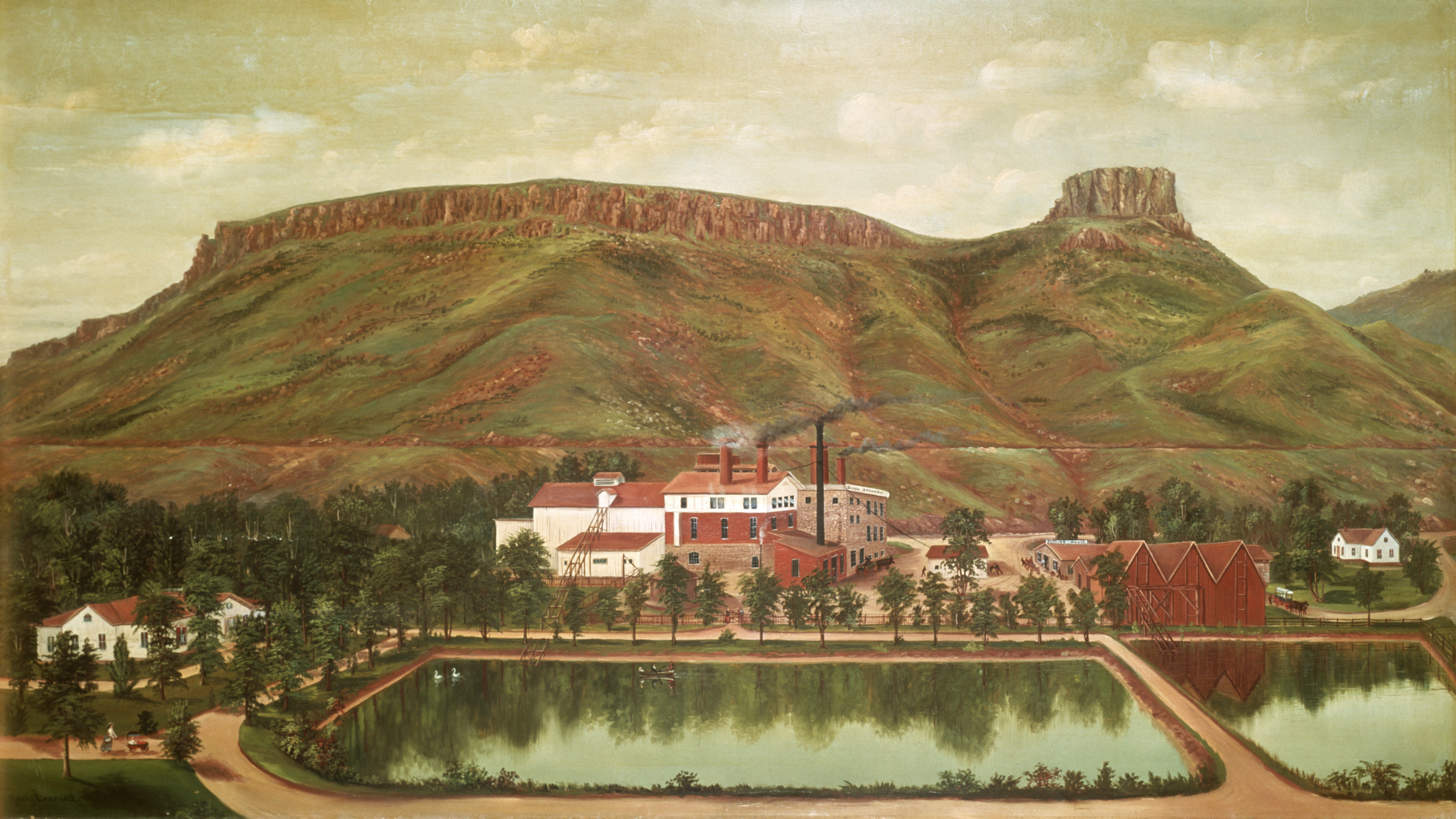
A watercolor depicting the Coors brewery as it looked in 1884, about a decade after Adolph Coors and Jacob Schueler repurposed an old tannery along the banks of Clear Creek in Golden, Colorado.
Last Sip
Coors came of age alongside its home state. As Colorado grew and transformed itself over the course of the twentieth century, Coors was along for the bumpy ride. The Adolph Coors Brewing Company was shoulder-to-shoulder with Schlitz, Budweiser, and Miller—the last giants standing tall as the Era of the American Behemoth Brewer reached its zenith in the 1970s. Fine light flavor and “drinkability” paired well with Coors’ high-country marketing, and Colorado’s brand soared to new heights with every Banquet Beer and Silver Bullet sold.
But for a growing number of Coloradans, the glitzy ads masked growing pains. The company’s star dimmed in the face of racist employment practices, labor strife, and a wide-ranging boycott. As Coloradans came to grips with a long history of racial discrimination that has yet to be fully addressed, Coors became a focal point in the era’s political clashes. For some, the Coors family and their brewery stood for all of the regressive racial attitudes and divisive politics of the age. Ultimately, the long-running boycott did not produce any clear-cut victories for activists or progressives, but it did tarnish the company’s mystique and hurt sales. By the late 1980s, a new generation of leadership at Coors was making amends with communities it had offended and working to move past (or some would say obscure and whitewash) its discriminatory and controversial history. Today the company is noted in some circles for its corporate citizenship, particularly in its commitment to LGBTQ+ employees and their families.
Coors marketing, inextricably tied as it was with its home state’s reputation, deftly promoted a vision of the good life in Colorado that drinkers could capture one can at a time. As the company ramped up its marketing efforts starting in the 1970s, cold cans of Coors became synonymous with the things many Coloradans loved: hiking trails, ski runs, and, starting in 1995 with the inaugural games and bespoke Blue Moon beer at Coors Field, major league baseball.
With its malting programs and deep know-how established by generations of brewers, Coors set the stage for Colorado’s craft beer boom. Brewmaster Keith Villa, creator of Blue Moon Belgian White, recalls helping the then-tiny New Belgium Brewing Company get its yeast strain right, and even Holidaily—the tiny niche all-gluten-free brewery just a few miles up the road from Coors in Golden—sourced its knowhow from former Coors employees who left the megabrewer to start their own breweries. New Terrain Brewing Company (another Golden favorite) looks out across the mesas at the site of Coors’s pre-Prohibition beer garden, drawing hordes of bikers and hikers from the nearby trails in much the same way that Coors lured in thirsty folks from around Denver and Golden to drink beer in a scene of dramatic natural beauty.
Head Brewer for New Terrain, Dave Johnson, thinks about this connection as he ponders the future of beer in Colorado. For him and many of the more than 400 craft brewers that have sprung up in Colorado, the connection Coors forged in the 1970s between beer and time outside helped set the stage for the microbrew movement of the 1990s as well as the state’s strong beer industry today. New Terrain’s popular brewery looks out across Clear Creek at what was once the Coors brewery’s beer garden and grove. The thirsty bikers and trail runners who congregate at New Terrain gather there for the same reason Coloradans flocked to banks of Clear Creek in the late 1800s—to enjoy a refreshing beverage and to cool off amid the natural beauty of Colorado’s Front Range.
Without Coors’s pioneering innovations in mass-market aluminum beverage cans, Oskar Blues would not have been able to find a way to put Dale’s Pale Ale in an aluminum can (the first craft beer to come in such a vessel). Today, aluminum cans are the gold standard for beer packaging, and many of the more than 400 breweries Colorado boasts in 2023 are able to send their beer home to consumers thanks to the “crowler”—a large, bartop-fillable aluminum can that’s become ubiquitous across the state thanks to innovations at Oskar Blues. It’s an innovation that owes its existence to Coors.
Today, international mega-mergers and consolidation in the mass-market beer industry have taken most of the Coors company out of Golden. By 2024, the Molson-Coors company’s headquarters will be in a high-rise tower in Chicago—a midwestern city Adolph Coors saw as an oversaturated market when he chose Colorado as the place to found his brewery in 1873. The classic Coors Banquet Beer is still made only at the company’s original brewery site tucked between the dramatic mesas that define Golden, Colorado. But even with its corporate HQ far away, Coors is still synonymous with its home state, and its rocky history mirrors Colorado’s own turbulent ups and downs.
Whether you are still boycotting Coors or it’s your go-to beverage for sipping at Coors Field, the beer’s story can show us much about ourselves and how our version of Colorado came to be.
